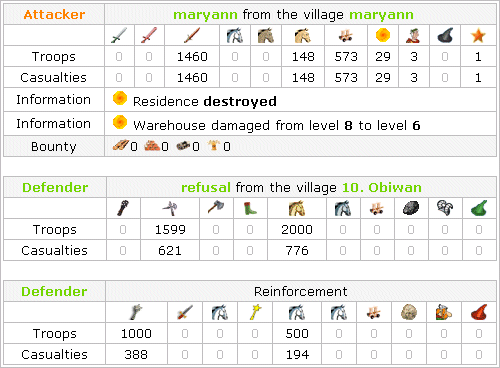
A timed counterstrike is used to kill off a player’s attacking army by timing your own attack at his village the moment his army returns.
The travel time can be calculated using the Travian Travel Calculator.
Supposing an attacker sends a clubswinger army at you and it takes exactly 1 hour 30 minutes to reach you. And the attack arrives at exactly 12:00:00. Since the travel time is 1 hour 30 minutes, then by reverse calculating, you know that the attacker’s army will return home at exactly 13:30:00.
Therefore, you should time a counterstrike attack back at his village to arrive precisely at 13:30:01, or one second after his army returns home. By timing a counterstrike, he will have no time to remove his troops.
You can send your counterstrike from your other village where you can easily time it and send it off at your leisure. But if you wanted to send the counterstrike from the same village that was under attack, then you need your army to travel at a different speed.
For example, if he sent a clubswinger army at you. Clubswingers travel at 7 fields per hour. Then you need to include an axeman in your army so your army travels at a different speed, at 6 fields per hour.
Since you take a longer travel time, then you should send your counterstrike attack before his attack arrives at your village.
This method works well in the early game with players who constantly dodge your attacks. If he sent a raiding party at you, then a timed counterstrike will easily kill his raiding party. And it works well to kill off a player’s returning chief, if the chief attacked you but didn’t manage to conquer your village in the first pass.
The setback is, the defender usually knows that your attack is real, and might call for reinforcements. But there is usually very little time for reinforcements to arrive, and in the early game, no one has any meaningful defenses.
If your village is being chiefed, you will probably want to do a timed counterstrike to kill off his chief. Be careful that your own village is not completely conquered over, because your troops will disappear if it is conquered.
Sniping the Chief.
This concept is similar to sniping catas and is explained in the previous chapter under “Defending Against Cata Attacks.”
Double Conquer.
Sometimes it is very difficult to defend against a conquer. If it has reached the stage where you will lose your village, then you can decide to just let it fall and then to re-conquer it back.
A newly conquered village has zero loyalty points and no resources to rebuild Residence. It also has minimal defenders and no walls which makes it very easy to re-conquer.
You don’t even need to send rams or catas. In this tactic, send your hammer with at least one chief and attack your own village. Time your attack so that your attack arrives shortly after your enemy’s attacks. This is a surefire tactic that you will get your village back.
The emphasis here is speed. You need to anticipate the timing well and move fast to retake your village. The setback is your village will suffer a population penalty, but that is still better than losing it outright.
Another setback is you will lose all troops, researches and armor/weapon upgrades if you let your village be conquered. Use this as a last resort only.
Fortifying Defenses.
It goes without saying, but the moment you realize you are under conquer attack, begin to build up a strong defense. Alert your alliance to ask for reinforcements and build up your walls as high as you can.
Rebuild your residence if it has been destroyed. Your loyalty rises with each level it is rebuilt, so build it as high as you can afford. A more effective strategy is to wait until your attacker resends his attacks, and then build a Palace instead.
Place lots of scouts to defend your village. A careful attacker will scout your village in between chief attacks – there’s no question about it. Denying him of a scouting report will buy you valuable time as you continue your defense buildup.

Fortunately, most conquers are executed by novices.
